| January
28, 2007
Neighbourhood Walks and Talks: Lucille Crighton
– A Textile Arts Hall of Famer & Gifted Gardener in the
Beach
Toronto’s Beach community
is not only a beautiful waterfront neighbourhood with mature trees
and historic houses, it is also one of the favourite places of residence
for a great many artists. I was glad I had a chance to discover
more about arts in the Beach when I accidentally connected with
a local artist, a photographer by the name of John Dowding, during
my interview with Mary Lee from Spiagga Restaurant. This gave me
an opportunity to learn more about the wide spectrum of creative
people in the Beach. John then connected me to Lucille
Crighton who is one of Canada’s foremost textile artists.
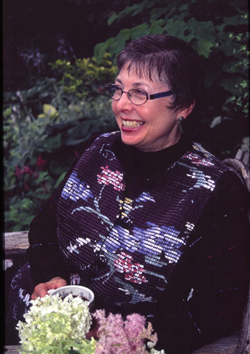
Lucille Crighton
On a snowy afternoon, after my interesting interview with Steven
Zarlenga and Paul Karamat, two creative bed and breakfast owners
in the Beach, followed by an interview with John
Dowding, I had a chance to visit Lucille Crighton at her home:
a beautiful historic property dating back to the first part of the
20th century. Lucille has a long attachment to Beach, as her grandfather
bought this very house in 1927. The brick came from rubble from
the Great Toronto Fire of 1904, and Lucille took me outside to show
me the darkened colour and rough texture of the bricks.
Lucille also has a long connection to the textile arts: she started
weaving as a teenager. With a chuckle she says she hesitates to
count the number of decades that she has been weaving now. She graduated
in design arts and textile arts, has a diploma in weaving with Nell
Znamierowski from FIT, NYC and also completed a program in teacher
training for professional hand weavers. She has written 2 of the
courses (Fabric to Fashion and Fabric Design Sample) for the OHS
master weaver program.
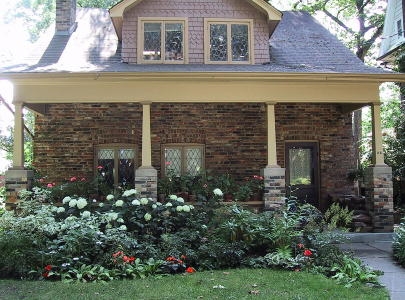
Lucille's house in the Beach, the bricks date back to Toronto's
Great Fire (1904)
When her children were small, she opened her own yarn store and
ran classes in quilting, macramé, knitting, weaving and needlework.
Lucille explained that at one point she decided to specialize in
weaving because it is an in-depth craft where you never stop learning.
Weaving reminds her very much of music; her brother Garry is a musician.
Designing a threading is quite analogous to writing music and the
intricacy of the threadings keeps you challenged for a long time.
Lucille used to teach weaving all over North America, in places
such as Washington DC, Portland, Oregon, Florida and Michigan, New
York, Massachusetts and Rhode Island. All these places have weaving
guilds, and they would invite her to teach colour and design in
weaving. Although she enjoyed it, she had to give it up since she
did not have enough time to produce the jackets that she has become
so well-known for. Lucille adds that she enjoys teaching, but she
loves designing.
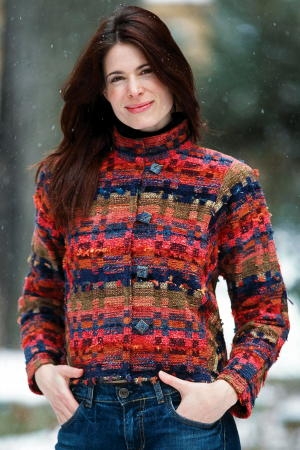
One of Lucille's designs
Lucille finds inspiration in daily life and constantly looks at
relationships of one colour to another, texture, line and pattern,
values and intensities. While weaving, she is intuitively considering
light reflection, rhythm and repetition, emphasis, balance and proportion
while experimenting with new harmonious colour combinations.
"Although I work long hours it is creative, it is inspiring
to put my ideas out there in terms of colour and design. I get up
every morning and love what I do.” But Lucille admits that
it took her a long time to get to this level of success. Today her
brilliantly coloured jackets are highly coveted fashion items, and
her customers often wait several months for Lucille’s creations.
Her special artistic craft was honoured when she was inducted into
the Hall of Fame at the One-Of-A-Kind
Craft Show, a popular trade show for unique arts and crafts,
held twice a year in Toronto.
Lucille and I went upstairs where three of her rooms are dedicated
towards her craft. The smaller loom is set up in a room with hundreds
of cones of yarn, all organized by colour, which presented quite
a beautiful arrangement by itself. Lucille explained that with the
Leclerc loom, bought in Canada, she uses up to 20 shuttles (the
longitudinal pieces of wood that are moved horizontally across the
vertical threads, creating a fabric one row at a time) for one jacket.
Each bobbin in the shuttle can be set up with a different colour
and as a result, Lucille can create very intricate designs as she
weaves, with occasional repeats in the same fabric.
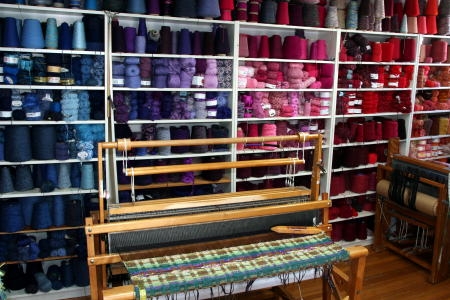
Some of the yarns
Lucille demonstrated to me how the weaving actually works: the
shuttle containing the thread is virtually thrown from side of the
loom to the other, creating an additional row. Then a “beater”
is used to compress the new line of thread and push it close to
the already woven fabric. Then pressing a foot pedal (treadle) a
new opening is created for the next row of yarn. She uses numerous
yarns of different thicknesses and materials; some of them have
metallic or even three-dimensional effects.
Weaving is a very physical process, you always sit hunched forward
and the process of throwing the shuttle produces a repetitive strain
on muscles and joints, particularly when you work every day from
morning to late at night. Lucille explains that she needs physiotherapy
every six weeks and daily exercises to relieve the physical strain
of her profession.
A second room features a larger California-built AVL loom that is
actually connected to a computer and a weaving
software program. Lucille added that this setup allows her to
create intricate fabric designs on the computer while in the past
graph paper would have had to be used. The software has made fabric
design so much more convenient and efficient than before.
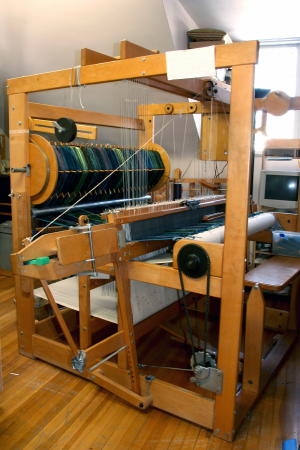
The California-built AVL loom
The third room is a cutting room where the woven fabrics are cut,
ready to be assembled into jackets. In addition this room houses
dozens of binders of fabric samples that Lucille has created over
the years, a tangible chronology of Lucille’s artistic evolution.
She could literally go back, for example, to November of 1996 and
show me what types of fabrics she was producing at that time. I
was admiring her organizational skills for keeping such exact records
of her artistic projects. She added that she never produces the
same fabric twice unless a customer specifically requests it. Now
I started to understand that this is truly a craft where you never
stop learning.
Weaving is indeed a very intricate craft: it takes about a week
to 10 days to set up the threads on the smaller loom while the setup
on the larger loom could take more than three weeks. This does not
include designing the warp, weighing and calculating yardages for
the yarns as well as searching out the yarns and ordering them.
Lucille sets up about 200 yards of warp yarn on the loom at a time
which allows her to create between 75 to 100 jackets from one setup.
The nature of weaving is such that on one warp you are able to create
completely different fabrics; you would not even think that the
designs came from the same loom.
It was obvious to me that considering the set-up and the manual
process of weaving a fabric row by row, weaving is an extremely
labour-intensive process. I inquired how much one jacket would cost
roughly, and Lucille responded that the average cost of a jacket
is in the C$650 to $1000 range. That was actually a lot more reasonable
than I had expected. Lucille explained that her customers are very
diverse and simply would like to own a one-of-a-kind garment that
is not replicated anywhere in the world.
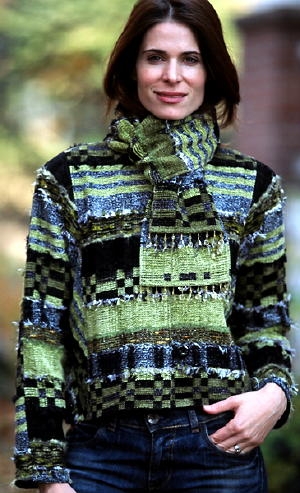
Now a well established successful artist, Lucille has a substantial
backlog of orders and does not have to worry about where the next
project is coming from. Her marketing consists of four art shows
a year: twice a year she participates in the popular One-Of-A-Kind
Trade Show in Toronto, while another two times a year she is a key
participant in the Beach Studio Tour.
The Beach
Studio Tour is organized twice yearly by a group of about 15
to 24 local artists in the Beach who open their homes to the public
free of charge for three days in May and October of every year.
Pottery, stained glass, jewellery, photography, fine art and textile
arts are represented, and the artists welcome the visitors with
demonstrations of their crafts and an opportunity to learn about
the creative process.
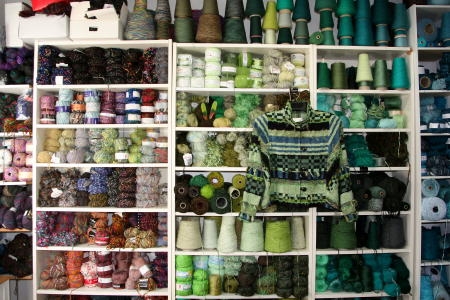
A whole rainbow of colour
The artists that participate in the Beach Studio Tour collectively
shoulder the arketing and publicity effort to promote this event.
They fundraise and sell advertising in their flyer in order to pay
for an advertising campaign. Brochures have to be designed, a mailing
list needs to be maintained, PR work needs to be done in order to
publicize this event and attract visitors from all over the city
and beyond. As a result, a lot of work has to be split between different
artists. But the Beach
Studio Tour has turned into a very popular regular event in
the neighbourhood that is a successful marketing tool for local
artists.
During the studio tour Lucille hires someone to give a tour of
the looms and answer questions, and her dining room becomes a showroom
for her creations. Usually she also features guest artists and during
the last few years well-known local photographer John Dowding has
showcased some of his work at Lucille’s home. She also hires
someone to help her on the main floor so potential clients have
a chance to talk with the master artist herself and be custom fitted
or to discuss future projects.
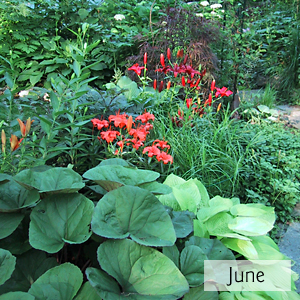
Lucille's garden
But Lucille is not only a gifted textile artist, she is also an
avid gardener. Horticulture is extremely popular in the Beach, a
neighbourhood with many talented gardeners. Lucille volunteers as
the librarian at the Beach
Garden Society and a member of the board which meets once a
month. The society brings in expert guest speakers who talk about
such topics as shade gardening and planting perennials. Lucille’s
garden was recently featured in Gardening
Life magazine.
Lucille
Crighton is an all around creative person, whether it be in
textile arts or horticulture and garden design. She is a one-of-a-kind
Hall of Famer and a good example of the creative talent in Toronto’s
Beach neighbourhood.

Lucille's garden
Related Articles:
Celebrate Toronto
- An article series to celebrate my chosen home town
Gene Domagala - A human convenience
store of charity and community involvement in Toronto's Beach
Arie Nerman & the Beach Hebrew Institute:
The People's Synagogue
Vivetha Bistro: A popular spot
with eclectic food
Glenn Cochrane - Media
personality, author and expert fundraiser – a champion of
the Beach for almost 40 years
Michelle Gebhart: A
true Renaissance woman: from army brat to expert renovator, biker
lady, successful restaurateur & dedicated youth volunteer
Michael Prue: A working class success
story - from Regent Park to Queens Park
Alex Winch & the
Beach Solar Laundromat – Unstoppable when it comes to championing
renewable energy & innovative entrepreneurship
Mary Lee: A restaurant owner with a heart
for the arts
Marie Perrotta from the Pegasus
Community Project reaches for the stars
Burgie and Benedetta from the Konditor
coffeehouse create Austrian delicacies in Toronto's Beach
Bob Murdoch from Community Centre
55 - 25 years of community service in the Beach
Steve and Paul from Accommodating
the Soul B&B: hospitality with a personal touch
John Dowding: A private lesson in
photography from a true master
Lucille Crighton: A textile
arts Hall of Famer in Toronto's Beach
Lido Chilelli: Founder
of the Toronto International Beaches Jazz Festival
Fire Station 227: History, heroism
and local connections in the Beach
The Green Eggplant: Healthy Mediterranean
food and big solid portions
The Balmy Beach Club - Legend
by the Lake & Toronto's best-kept secret
The Garden Gate Restaurant a.k.a. "The
Goof" - Good food in the Beach since 1952
Ralph Noble: Firefighter,
lifesaver and creator of the most famous mural in the Beach –
a noble man indeed
Sandra Bussin
- City Councillor and Deputy Mayor shows me her neighbourhood
The Toronto Beach Rotary Club:
Service above Self and the joys of volunteering
The Beaches Lions
Club: Charity and community projects in the Beach since 1935
The Beach Business
Improvement Area: A general overview of the Beach and the merchants
and activities on Queen Street East
Maria Minna:
An Italian-Canadian immigrant story and a life-long fight for social
justice
The Beach Metro Community
News: Much more than just the news
The Kingston Road Business Community:
A neighbourhood undergoing revitalization and an integral part of
the Beach
Andrew Smith and Rachel Howard:
Creative entrepreneurs and dedicated community builders
Nevada's Ristorante: Where
hospitality is a family affair
Maria Minna: Another neighbourhood
walk and talk and discoveries along Queen Street East
St. Aidan's Church:The spirit of charity
in the Beach comes full circle
Gene Domagala takes me on a history
tour of the eastern and northern part of the Beach - a perfect day
of discovery
The Beaches Library: A centre
of learning for all ages
A walk along Kingston Road:
A shopping district definitely worth a visit
55 Division: Serving and protecting
- community policing in action
|